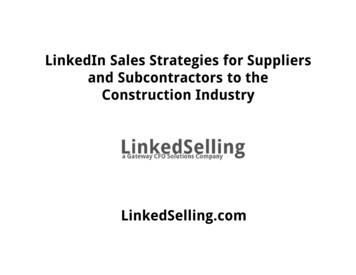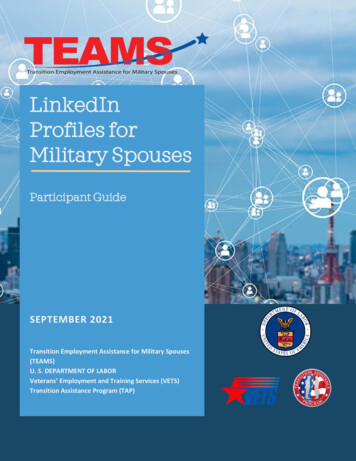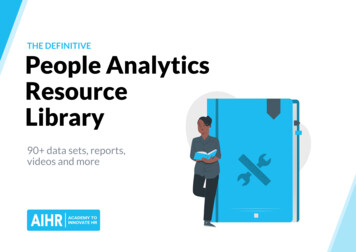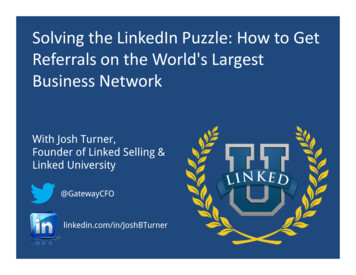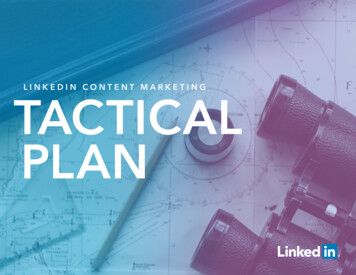
Transcription
Crash CourseinMetrics & AnalyticsUnderstand Metrics vs. AnalyticsFind the Right Metrics for YouMeasure Full Funnel Impact
ContentsClick each chapter to view1234562› The Sophisticated Marketer’s Crash Course in Metrics and AnalyticsIntroduction: WhyDo I Need Metricsand Analytics?Learning from“Moneyball” MetricsKeep it Simple witha Two-Stage FunnelReaching Prospectsin the Upper FunnelNurtureRelationships in theLower FunnelApplying Analyticsto the Full Funnel7891011Measuring your FullFunnel Impact onLinkedInOvercomingthe AttributionChallengeDetermining WhatMetrics Matterfor YouThe Power ofCustomer MetricsConclusion
Introduction: Why Do I Need Metrics and Analytics?1IntroductionWhy Do I NeedMetrics and Analytics?
IntroductionWhy Do I Need Metrics and Analytics?B2B marketers are being held to new levels of accountability inthis data-driven and buyer-empowered era.Businesses have accepted the fact that theirbuyers are largely in control along the pathWhat is the difference betweenmetrics and analytics?holding sales reps at arm’s length until lateThe simple way to understand metricsin the process. Hand in hand with this reality,and analytics and the difference betweenB2B businesses recognize that the marketingthem is this: Metrics are what you measureteam now interacts with and influencesabout your marketing programs to gaugeprospects far more than in the past. As theyperformance or progress. Your mostincreasingly rely on marketing to attract andimportant metrics are your key performancedrive prospective buyers through the funnel,indicators, or KPIs. Analytics use metricscompanies expect marketers to prove theand how they’re trending to help you makevalue of their spend from brand awareness todecisions about your marketing efforts.impact on revenues.Metrics and analytics are both important.With metrics and analytics, they can do justYou can’t have analytics without metrics,that. By substantiating that their marketingbut metrics alone won’t help you take actionefforts pay off — ultimately by contributingthat can improve your results.to revenues — B2B marketers can confidentlyreport the ROI of their programs and requestNick Panayi, Head of Digital Marketing andlarger budgets. Doing so requires a clearGlobal Brand at CSC, offers this conciseunderstanding of metrics and analytics.summary of the difference between metricsContentsversus the ‘so what.’” In other words,metrics are the “what,” and analyticsto purchase — and that these buyers are4and analytics: “The difference is the ‘what’› Introduction: Why Do I Need Metrics and Analytics?supply the “so what.”According to Forrester Research,as much as90%of the buyers’ journey may becomplete before they contact asalesperson. During that time,marketing is responsible for movingprospects down the purchase path.
For instance, metrics might show a risingAt the most effective companies, analyticsbounce rate despite a boost in website traffic.and metrics go hand-in-hand. They areWith analytics, you can discern the answer tointertwined: For example, one of the keywhy your bounce rate is increasing: perhapsgoals of analytics when it comes to marketingbecause the traffic you’re driving is not youris determining which metrics are the mosttarget audience.important for your business. Which are thegenuine KPIs. And which are the ones thatThe difference between metrics and analyticspredict how well your business is performing.is not just semantics; it’s very real. “Bigdifference,” says Andy Crestodina, StrategicFor many modern marketers, metrics andDirector of Orbit Media Studios.analytics are an essential part of the businessday. CSC’s Panayi checks his metrics first thing“Metrics are just numbers. Analytics is makingin the morning. “Every single morning beforedecisions.” He adds: “You can get all kinds ofmy morning coffee,” he says. “It’s betweennumbers and all kinds of metrics on lots ofcoffee one and coffee two, worst case.”Marketing organizations looking todevelop a sophisticated system ofmetrics and analytics would requirethe following essential platforms formeasuring impact: Analytics Platform Marketing Automation Platform Social Media Measurement Platformpretty charts, but analytics implies decisionmaking. It implies analysis, implies that youMetrics and analytics are crucial to marketers.are actually going to take an action that willIn this ebook, we will examine both, butData is all the information aboutmake a difference in your marketing.”because analytics are unique to individualbuyers: their interests, things that theybusinesses and the available metrics are morelike on Facebook, what they followEven with the best metrics and top-of-the-universal, we will spend more time exploringon social media, what content theyline software, you’re still going to need smartthe ins-and-outs of various metrics to helpconsume. We can capture all of thatpeople to interpret the metrics and do theyou decide which are the best fit for yourdata, and then use it to our advantagehard, intellectual work of analytics. Analytics,business and the goals of your analytics team.as marketers.Crestodina says, “is something that only ahuman can do, not a piece of software.”Meagen EisenbergCMO, MongoDB, Inc.5Contents› Introduction: Why Do I Need Metrics and Analytics?
Learning from “Moneyball” Metrics2Learningfrom“Moneyball” Metrics
Learning from “Moneyball” MetricsMarketers can use many metrics to prove ROI, but the specificmetrics a particular marketer uses should align with her — and hercompany’s — goals.Does she want to drive awareness? Thenbase and score runs, while a cleanup hitter’sThe key is to zero in on the metrics thatbrand lift and website traffic are appropriatejob is to drive in runs. A baseball team wouldmatter, the ones most closely aligned withmetrics. Does she want to drive revenue?never measure the performance of these twoyour objectives throughout the funnel. WhileThen Sales Accepted Leads (SALs) andplayers in the same way. The leadoff hitter isthe ultimate goal is to generate revenues, it’srevenue metrics make sense. Mostmeasured by on-base percentage and runsimportant to measure the effectiveness ofmarketers, of course, want to do both, but doscored, while a cleanup hitter is measured byeach program and interaction designed toso at different times with different prospectshome runs and runs batted in (RBI). It’s thepush prospects into and through the funnel.at different stages in the funnel. And thensame in marketing: You wouldn’t measurea marketer will want to use analytics toa branding campaign, where the goal isIn other words, you need to track anddetermine what the metrics are indicatingawareness, the same way you would measuremeasure the right metrics for each marketingand how the business can be improved usingan email campaign offering a producttactic as prospects move from awarenessthis information.discount, where the immediate goal is sales.to purchase. Only in this way can you makesmart decisions about which programs to cutLet’s use baseball as an analogy. Billy Beane,the Oakland A’s general manager and heroof “Moneyball,” made baseball managersand owners rethink the metrics they use tomake multi-million-dollar decisions. Howthe sport now measures player productivityoffers an interesting lesson for marketers.In baseball, a leadoff hitter’s job is to get on7Contents› Learning from “Moneyball” MetricsAre your metrics relevant?Successful marketers do more thandrive likes, shares, or click-throughs:they drive revenue. With that in mind,understand the metrics that mattermost to your C-suite so you can track,analyze, and report on them.and which to keep, and continually improveyour efforts over time.
Keep it Simple with a Two-Stage Funnel3Keep it SimplewithA Two-Stage Funnel
Keep it Simple with a Two-Stage FunnelThere are many ways to represent the concept of attracting, engaging, and convertingprospects from beginning to end of the buyer’s journey. This is commonly referred toas the “funnel,” which we like to keep simple with this two-stage framework.The funnel helps visualize the process of firstreaching your target audience and then nurturingthe relationship until you acquire prospects asReachUpper Funnel:customers. Put another way, if you can reach the rightIncrease awarenessBuild brandShape perceptionprospects and successfully cultivate a relationshipwith them, you’ll see the results in the form ofnew customers.In the past, many marketers focused on reach andNurtureLower Funnel:awareness programs in the upper funnel. ThisImprove lead qualityIncrease conversionDrive pipeline and revenueapproach made sense when prospects were muchmore likely to connect earlier in the process with asales rep who would nurture these leads. But nowthat B2B buyers are not engaging sales reps untilmuch later in the process, marketers must be fullAcquireThe ultimate goal of reaching and thenfunnel marketers who invest in programs and tacticsnurturing prospects is to “acquire” them, tothat reach and nurture prospects throughout theirdrive them toward becoming a customer.journey. In other words, marketing’s responsibility isto stay in front of prospects and help educate themthroughout the process, until prospective buyers areready to talk to sales. That’s the reason for the rise of9Contents› Keep it Simple with a Two-Stage Funnelfull funnel marketing.
Each marketing tactic should have a clear purpose and map tothe buyer’s journey. To do this effectively, ask yourself:123What is full funnel marketing?Full funnel marketingis about ensuring youcan play an active rolein prospect educationWho is your target audience andWhen you know prospects areWhat happens after the sale?what do they need from you asinterested but not yet readyDo you have content that setsthroughout the buyer’s journey. Inprospects attempt to educateto buy, you can nurture themup customer for success afterthe upper funnel, you’re reachingthemselves on the various wayswith increasingly specific andthey’ve bought from you? Doyour target audience, even when theythey can address their painmore detailed content basedyou have content that helpsare not in the market for yourpoints. That’s the Reach stage,on your growing understandingretain current customers orwhere brand awareness reigns.of who they are, their interests,helps your sales team upsell orofferings. In the lower funnel, you’reand their level of engagement.cross-sell?That’s the Nurture stage, andyour job is to inspire and inform,moving prospects steadilytoward a purchase.10Contents› Keep it Simple with a Two-Stage Funnelnurturing prospects until they areready to purchase.
To succeed at full funnel marketing:1. Understand the key objectives you needto hit at each stage of the funnel.2. Pin down the right metrics to measureprogress against those objectives.3. Deploy the most effective programs toknowledgeable and helpful. In the lowerfunnel, whitepapers and videos can educateand engage prospects. Moreover, webinarsand more product-focused content can driveleads, conversions, and even sales.That said, before you develop any programsachieve your objectives and continuallyor tactics, define your ideal lead by workinguse analytics to gauge the effectivenessclosely with your sales team. Determineof these programs and to optimize theirwhich business demographics and prospectperformance.behaviors indicate they’re a good lead.Otherwise, you’ll only waste time, effort,It’s important to understand the roles thatand budget.various programs and tactics can play inhelping you achieve the end goal of drivingThe most effective marketers are deployingrevenues. For example, online displaytheir metrics and analytics to make sure theadvertising should not be considered aleads they are passing to the sales teams are“top funnel only” strategy; it has provenones that are highly likely to result in revenue.remarkably effective when used inCSC’s Panayi says that sales accepted leadscomprehensive programs that reach eachare a critical metric for his team. “This is thestage of the marketing funnel.most important hand off,” he say, adding:“If you fail the handover, you lose credibilitySimilarly, content marketing is a fullwith sales, and then you don’t have thefunnel tactic. In the upper funnel, thoughtopportunity to take your good at the top ofleadership blog posts and native advertisingthe funnel and transfer it into a close atcan be used to establish your brand asthe end.”11Contents› Keep it Simple with a Two-Stage FunnelThe funnel metaphor, at its basic level,is that there are more people that arealways starting the process than thereare at the buying stage. There are morepeople who aren’t ready to buy thanare ready to buy.Michael BrennerHead of Strategy, NewsCred
Reaching Prospects in the Upper Funnel4ReachinginProspectstheU pp e r F unn e l
Reaching Prospects in the Upper FunnelLet’s break down the tactics needed in both stages of the funnel. In the upperfunnel, your goal is reaching your audience at scale to build awareness and a positiveimpression of your brand, even with those not yet in the market for your offerings.Keep in mind that you don’t just want moreof the lead-off hitter (i.e., your upper funneltraffic to your website, you want more trafficprograms and tactics) versus your cleanupfrom your target audience.hitter (i.e., your lower funnel programsand tactics).You’re also trying to reach influencers withina company and not just the final decisionThe following are useful metrics for measuringmaker. You can achieve this awareness at scalethe effectiveness of upper funnel programs:with thought leadership and issues-oriented1. Awarenesscontent, plus other forms of brand messages,2. Branded searchdelivered though native advertising and3. Brand recall and liftdisplay ads. Laying this foundation makes4. Website and referral traffic liftthese prospective buyers more receptive to5. Targeted page views, pages per visit, andyour outreach and messages as they entertime spent on site lifttheir consideration stage (i.e., your lower6. Subscriber/opt-in liftfunnel).7. Targeted engagement (open rate, shares,likes, comments)Both the upper funnel and lower funnel8. Bounce rate declinedemand different metrics to measure their9. Targeted unique visitors liftdifferent, but intertwined, goals. You need10. Inbound links liftto determine how to measure the impact13Contents› Reaching Prospects in the Upper FunnelReach
ReachThe table below lists metrics aligned with various tactics you might use in theupper funnel to drive awareness of your brand with the right people.TacticMetricsThe buyer’s journey is not reallyEmail marketingOpen rate, website traffic, opt-ina linear path anymore. It’s moreDisplay adsAwareness, brand recall and liftSearch marketingBranded searchPRAwareness, brand lift, website traffic,inbound links, referral traffic, unique visitorsSocial media engagementShares, likes, commentsSocial media advertisingAwareness, brand recall and lift, websitetraffic, unique visitorsUngated long-form writtencontent (e.g., white paper, eBook)Website traffic, shares, likes, bounce rate,unique visitors, inbound links, referral trafficUngated short-form writtencontent (e.g., articles, blog posts)Website traffic, shares, likes, bounce rate,comments, unique visitors, inbound links,referral trafficRich media content (e.g., video,webinars)Time spent, page views, pages per visit,opt-inabout being ready with the contentthat prospects need when they aremaking a decision.Dillon AllieVP of Client Services, HDMZ14Contents› Reaching Prospects in the Upper Funnel
Case Study: RepliconCase StudyHow data-driven hybrid marketers revthe Replicon demand gen engine400%more leads within target audience (vs. leadgeneration efforts on other platforms)Despite being around for almost twovia email with the HubSpot platform, eventdecades and already having thousandsmarketing, and LinkedIn Sponsored Updatesof customers worldwide, Replicon,and LinkedIn Sponsored InMail. And thewhich produces a software-as-a-serviceReplicon marketing team is measuring thetime management system, sees a hugeimpact of these tactics on a daily basis andopportunity for growth. Two years ago,using analytics to continually boost theirReplicon raised 20 million in its first roundperformance.of funding. Since then, the business has beengrowing at a fast pace, averaging 40 percentTo be a successful marketer, youyear-over-year growth.Metrics that matteredEngagementneed to understand data. When IA data-driven marketing approach is keythink about being a marketer on ato driving that revenue growth. Replicon’sday-to-day basis, I can’t do my jobmarketing team, led by Brett Chesterunless I know what’s working andand Victor Lin, uses variety of data-drivenCost per leadtactics that can be adjusted in minutes.The LinkedIn program costper lead was 73% lower thanthat of AdWordswhat’s not working.Brett ChesterThese tactics include content marketing,search engine marketing, lead nurturingThe LinkedIn SponsoredInMail had a 48% open rateVP Online Marketing, RepliconContents› Case Study: Replicon15
Nurture Relationships in the Lower Funnel5Nurture Relationshipsin theL ow e r F unn e l
Nurture Relationships in the Lower FunnelIn the lower funnel, you “nurture” prospects that have either implicitlyor explicitly expressed an interest in your brand, product, or service.But keep in mind that research shows 95 percentsite, you can nurture them with progressiveof visitors to websites do not convert — in othermessaging and a sequential story that aligns withwords, they do not share their email addressestheir place in the research or buying process.with you or reach out to sales. Even of thoseprospects that have shared their emails withThe following are useful metrics for measuringyou, 80 percent will not open your emails onthe effectiveness of lower funnel programsaverage. That means relying on email alone isand tactics:not sufficient. By instead taking a multi-channelnurturing approach — calling upon social anddisplay advertising and phone outreach in1. Website form conversion rate2. Leads (organic vs. paid); cost per leadaddition to email — you can better engage3. Marketing qualified leads; Cost per MQLall prospective buyers. In other words, both4. Sales qualified opportunities (SQOs)anonymous prospects who have not shared their5. Sales accepted opportunities (SAOs)email address and known prospects who haveshared their email address.6. Qualified lead velocity rate (i.e., growth inqualified leads)Remember: Today’s technology allows you to7. Pipeline contributionlearn a lot about anonymous website visitors,8. Revenue contributionincluding their business demographics and9. Retention rate and/or customer lifetimeonline behavior. After these leads visit your17Contents› Nurture Relationships in the Lower Funnelvalue and/or upsell/cross-sellNurture
NurtureBelow are these metrics aligned with various tacticsyou might use in the lower funnel.If you invest in that top ofTacticMetricsEmail marketingOpen rate, returning visitors, form fills,MQLs, SAOs, SQOs, retention rateacquisition costs of deals notSearch marketingLeads, cost per lead, form fills, MQLsonly in the medium future butDisplay adsLeads, cost per lead, form fills, MQLsalso well beyond. There’s anPRLeads, cost per lead, returning visitorsSocial media advertisingLeads, cost per lead, returning visitors,MQLs, form fillsGated long-form written content(e.g., white paper, eBook)Form fills, leads, cost per lead, returningvisitors, MQL, SAO, SQO, close rate,revenue, retention rateWebinarsForm fills, leads, cost per lead, SAOs, SQOs,close rate, revenue, retention rateDemos/trialsForm fills, leads, cost per lead, SAOs, SQOs,close rate, revenue, retention ratepipeline content, if you invest inthese early-stage relationships,you significantly subsidize theannuity to that: you’re loweringyour acquisition costs.Matt HeinzPresident, Heinz Marketing18Contents› Nurture Relationships in the Lower Funnel
Case Study: eCornellCase StudyeCornell drives higher conversion rateswith LinkedIn Lead AcceleratorI think one key thing LeadAccelerator does right is this — assoon as a prospect engages andshows interest in a particularprogram, they start receivingsequenced messaging that’srelevant to the specific programthey’ve shown interest in. Youcan see the impact of this in theperformance and you can see it inthe quality of each lead.Andrew HickeyFormer Director of DigitalMarketing, eCornell200%higher landing page conversion rate with LinkedIn LeadAccelerator (vs. traditional marketing campaigns)eCornell, is a subsidiary of Cornell University,has been very active across multiplemarketing channels to help prospectivestudents learn more about their onlineprograms. But deciding to actually enroll ina program takes time. eCornell needed tostay closer to their prospects with relevantcontent that helps guide them through thedecision process.LinkedIn Lead Accelerator enabled eCornellto deliver sequenced ads and content toprospective students through display andsocial advertising, and nurture them whetherthey had shown interest in a specific programor were just perusing eCornell’s home page.Instead of waiting for prospects to returnto our site and dig deeper, eCornell took amore proactive and effective approach bynurturing them with a series ofrelevant offers.Metrics that matteredOrganic Lead VolumeAfter eCornell launchedLinkedIn Lead Accelerator,the data shows a 34% lift inorganic lead volume.Cost per leadThe CPL on Linkedin LeadAccelerator is 300% lowerthan traditional retargeting.Revenue Per LeadLinkedIn Lead Accelerator’sRevenue Per Leadperformance was 1,000%better than GoogleRemarketing. Not a typo.One thousand percent.Contents› Case Study: eCornell19
Applying Analytics to the Full Funnel6ApplyingAnalyticsto theF ull F unn e l
Applying Analytics to the Full FunnelIn all cases, use the tactics that make sense for your organization — in other words, the ones that willreach your target audience where they’re looking to consume content and that most resonate with them.Whatever tactics you use, determine your goals and corresponding KPIs for each and track and measurethose over time. And remember: the upper and lower funnel are inseparable. It may be easier to measurelower funnel results, but you need the upper funnel to drive tomorrow’s buyers into the lower funnel.Full Funnel Goals andTracking MetricsGoalReach your audience at Awareness Subscriber/opt-in liftscale to build awareness Branded search Brand recall and lift Engagement (open rate,shares, likes, comments) Website and referral traffic lift Bounce rate decline Page views, pages per visit,and time spent on site lift Unique visitors liftand a positive impressionof your brandReachGoalNurtureTrackTrackNurture prospects until Leads (organic vs. paid) Form fillsthey’re ready to make a MQLs/Sales AcceptedOpportunities (SAOs) Revenue Sales Qualified Opportunities(SQOs) Close ratepurchase Cost per lead Qualified lead velocity rate(i.e., growth in qualified leads)21Contents› Applying Analytics to the Full Funnel Inbound links lift Returning visitors Retention rate and/orcustomer lifetime value and/or upsell/cross-sell
Analytics throughout the funnelLooking deeper into these metrics,every few months. Because the sales teamIn the upper funnel, marketers have accessmarketers can leverage analytics towasn’t equipped to handle so many leads atto a number of metrics that show how theirdecide on courses of action that will boostonce, the system was inefficient. Eisenbergmarketing efforts are trending. Is brandedmarketing performance in the lower funnel.led a push to have the leads entered intosearch up or down? Is targeted websiteUsing analytics, marketers can answerMongoDB’s system in real time. “It’s a muchtraffic increasing? Is my newsletter subscriberquestions, such as, how are my emailsmoother experience,” Eisenberg said.base growing?programs performing today? How can I make“The follow-up is much better. Until I sawthem perform better next year? Should I be(those metrics), I would have no idea thatMarketers can leverage these metricsmoving budget away from search? And if so,was happening.”and find actionable insights by deployingwhat other lower funnel programs can driveanalytics, which can be used to answermore qualified leads to the sales team?questions such as, where am I getting theAnalytics in action, part 2most bang for my marketing buck? How areAnalytics in action, part 1Andy Crestodina, Co-Founder/Strategicmy awareness and brand building programsThe most effective CMOs are using analyticsDirector of Orbit Media Studios, relayedperforming today? This month? This quarter?to assess their performance as prospectsan example of how his team used analyticsAnd how can I improve them next quartermove through the funnel. For example,to boost the ecommerce performance of aand next year? Should I be shifting moneyMeagen Eisenberg, CMO of MongoDB,client by 22%. Analytics showed poor salesfrom underperforming media? And if so,shared an example of how her companyconversions from the mobile platform.what other branding programs can deliverused analytics to improve the flow ofthe biggest boost to filling the upper funnelleads from the upper funnel to the lowerThe client decided to optimize its websitewith the right prospects?funnel. Recently, Eisenberg took a look atfor mobile sales, which led to the 22%a weekly lead report and found that theincrease in the number of website visitorsAs in the upper funnel, in the lower funnel,leads had ballooned from the typical 2,000who conducted ecommerce transactions viamarketers have a number of metricsto 20,000. “I said, ‘What the heck? What isphone. “That 22% lift meant that the work tothat indicate how their programsthis?’” Eisenberg recalled. Analyzing themake the website responsive paid for itselfare performing. Are prospectsmetrics revealed that the leads originatedwithin a few weeks,” Crestodina said.opening my emails? Is the same teamfrom a program that wasn’t connected toaccepting my leads? Are my programsMongoDB’s marketing automation system,influencing revenue?and so those leads were only processed22Contents› Applying Analytics to the Full Funnel
How to Measure Metrics on LinkedIn7MeasuringyourFull Funnel Impactonon L ink e d I n
With LinkedIn Marketing Solutions, youcan address branding, lead generation,and nurturing strategies in a holistic way— and measure the results.How to MeasureCampaigns on LinkedInProducts for Full Funnel MarketingLinkedIn Marketing Solutions offers the only platform thatimpacts every stage of your marketing funnel. Our productsReachhelp you generate awareness, reach more of the right peopleReach the right professional audienceswith your marketing programs, and nurture these audienceswith accurate targeting across LinkedInby delivering the most relevant content depending on whereas well as a network of business andprospects are in their purchase decisions.professional publisher sites.Full-funnel analytics & reportingNurtureDeliver helpful content at the rightOnsite Displaytime, based on who your prospectsNetwork Displayare and what matters to them.ReachSponsored UpdatesMeasureTrack branding and directSponsored InMailresponse impact with simple yetpowerful analytics.Lead AcceleratorNurture24Contents› How to Measure Metrics on LinkedIn
LinkedIn Display AdvertisingTo help you keep your company’s brand and content in front of prospects throughout thebuying process — whether they are on or off LinkedIn — LinkedIn Display Advertising offersboth Onsite Display and Network Display.ONSITE DISPLAYWith LinkedIn Onsite Display, you canput your brand in front of more than 400million members on the LinkedIn network1,choosing from a variety of display formats.That includes everything from IAB standardformats to native ones such as SpotlightAds and Follow Company Ads. You caneven display ads on various LinkedIn pages,including profile pages, home pages, inbox,search results pages, and groups pages. Byusing extremely targeted and contextualads in a quality professional context, youcan reach and engage a large universe ofpotential buyers.You can also take advantage of LinkedInText Ads, self-service ads that allow you todisplay a text ad and small image. Just aswith LinkedIn Onsite Display, you can getthese ads in front of LinkedIn members ofyour choosing in prominent spots across ourplatform, for higher reach and engagement.1As of September 201525Contents› LinkedIn Display Advertising
NETWORK DISPLAYTo complement the contextual targeting enabled by LinkedIn Onsite Display, LinkedInNetwork Display Advertising is designed to help you get in front of the right audienceson a frequent basis. This display advertising option allows you to reach prospects withFull funnel marketing is thenew three-martini lunchaccuracy and at scale as they consume information on LinkedIn and across the Web. ThisThe “getting to know you”includes extending your reach across LinkedIn’s network of 2500 business publisherperiod between businessessites and beyond, targeting your audience through the Ad Exchanges, but always in aand buyers takes placebrand-safe environment. By frequently connecting with your target audience, you increasetoday online, not in personawareness and engagement.over lunch and drinks. Content takesplace of the three-martini lunch — butit’s marketing driving the conversation3 Metrics for SuccessTo measure the impact of display advertising, marketers can usea range of metrics that rely on the LinkedIn platform as well othersystems to track them. Below are some key display advertising metrics:1. Targeted impressions2. Targeted website traffic3. Targeted engagement26Contents› LinkedIn Display Advertisinginstead of sales.
LinkedIn Sponsored UpdatesIn addition to providing relevant content to prospects during the buying process, you mustthink about reaching your target
Analytics use metrics and how they’re trending to help you make decisions about your marketing efforts. Metrics and analytics are both important. You can’t have analytics without metrics, but metrics alone won’t help you take action that can improve your results. Nick Panayi, Head of Digital Ma
